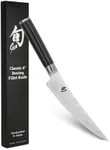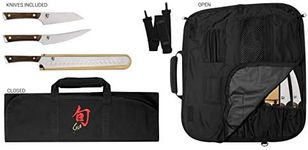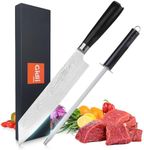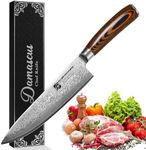Buying Guide for the Best Butcher Knives
Choosing the right butcher knife is essential for anyone who wants to efficiently and safely process meat. Whether you're a professional butcher, a home cook, or a barbecue enthusiast, the right knife can make a significant difference in your kitchen experience. When selecting a butcher knife, consider the following key specifications to ensure you get the best fit for your needs.Blade MaterialThe blade material of a butcher knife is crucial as it affects the knife's durability, sharpness, and ease of maintenance. Common materials include stainless steel, high-carbon steel, and ceramic. Stainless steel is resistant to rust and easy to maintain, making it a good all-around choice. High-carbon steel is known for its sharpness and edge retention but requires more care to prevent rust. Ceramic blades are extremely sharp and lightweight but can be brittle. Choose a blade material based on your willingness to maintain the knife and your need for sharpness and durability.
Blade LengthBlade length determines the knife's versatility and the types of tasks it can handle. Butcher knives typically range from 6 to 14 inches. Shorter blades (6-8 inches) offer more control and are suitable for smaller cuts of meat and detailed work. Medium blades (8-10 inches) provide a balance between control and versatility, making them ideal for general use. Longer blades (10-14 inches) are best for large cuts of meat and heavy-duty tasks. Consider the types of meat you usually work with and choose a blade length that matches your needs.
Blade ShapeThe shape of the blade affects how the knife performs different tasks. Common shapes include straight, curved, and scimitar. Straight blades are versatile and good for general cutting and slicing. Curved blades allow for a rocking motion, making them ideal for trimming fat and sinew. Scimitar blades have a pronounced curve and are excellent for breaking down large cuts of meat. Think about the specific tasks you will be performing and select a blade shape that complements those tasks.
Handle MaterialThe handle material impacts the knife's comfort, grip, and durability. Common handle materials include wood, plastic, and composite. Wood handles offer a traditional look and feel but require more maintenance to prevent cracking and warping. Plastic handles are durable, easy to clean, and often have a textured surface for a secure grip. Composite handles combine the best of both worlds, offering durability and a comfortable grip. Choose a handle material that feels comfortable in your hand and suits your maintenance preferences.
Weight and BalanceThe weight and balance of a butcher knife affect how it feels during use and how easily you can control it. A well-balanced knife will feel comfortable and stable in your hand, reducing fatigue during extended use. Heavier knives provide more power for cutting through tough meat and bones, while lighter knives offer better control for detailed work. Consider your strength and the types of tasks you will be performing to choose a knife with the right weight and balance for you.
Edge TypeThe edge type of a butcher knife determines its cutting performance and maintenance needs. Common edge types include straight, serrated, and granton. Straight edges are versatile and easy to sharpen, making them suitable for most tasks. Serrated edges are excellent for cutting through tough or crusty surfaces but can be more challenging to sharpen. Granton edges have small dimples along the blade that reduce friction and prevent meat from sticking, making them ideal for slicing. Choose an edge type based on the specific tasks you will be performing and your willingness to maintain the knife.





















